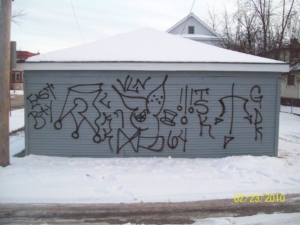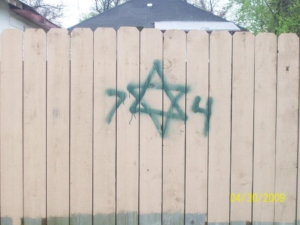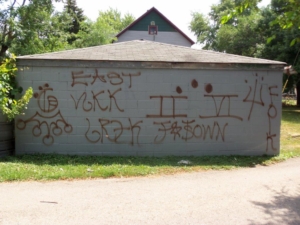Gang Prevention
Background
The 1950s brought a huge population boom to the Joliet area, primarily as a result of the increase in available jobs. Along with the limestone and steel industries that had been present since the middle of the previous century and the massive railroad system, the Exxon Mobile oil refinery was started in Joliet. This led to the building of the Poole public housing unit in 1954, the Des Plains homes in 1959, and the Fairview Projects in 1965.
By the 1980s, many of these jobs were closed permanently and poverty increased in the area greatly. With the decline of jobs and increase poverty, the 1980s brought the settlement of four major gangs to Joliet: the Conservative Vice Lords; the Black Gangster Disciples; the Latin Kings; and the Two Six. All four of these gangs began recruiting in Joliet in 1982 and remain active today. Additionally, the Joliet Correctional Facility or Statesville Maximum Security Prison may have initially attracted some gang members: some people relocated to be near family and friends who were incarcerated there, and gang members themselves began settling on the east side shortly after their release.
The number of gangs and gang members has dramatically increased throughout Will County over the years. The Illinois Streetgang Terrorism Omnibus Prevention act defines a gang as “any combination, confederation, alliance, network, conspiracy, understanding, or other similar conjoining, in law or fact, of 3 or more persons with an established hierarchy that, through its membership or through the agency of any member engages in a course or pattern of criminal conspiracy.” 740 ILCS 147/10.
State’s Attorney Glasgow established the office’s Gangs Unit in 1993, shortly after taking office in December 1992. At that time, street gangs were terrorizing many sections of Will County and gangs had a stronghold in many local neighborhoods. The State’s Attorney worked with local police to target the gang leaders responsible for the violence that was destroying so many lives and wreaking havoc in so many neighborhoods. In that first, unprecedented gang sweep, 47 high-level gang members were taken off the streets. Gang shootings in Joliet alone the following year dropped from a record high of 296 to 180. This aggressive and innovative interdiction, which eliminated all gang shootings for three full months, was featured on Peter Jennings’ World News Tonight.
In the continuing assault on gang violence, the State’s Attorney’s Office and local police joined forced with federal authorities on a number of gang sweeps over the years. One sweep during the late 1990s targeted the Latin Kings. Another hit the Gangster Disciples. These efforts were successful in disrupting gang activity by taking leaders off the streets with extended federal sentences. Over the years, we have continued to see periodic spikes in violence as gang leaders cycle in and out of prison and young members rise into leadership positions.
Law enforcement in Will County is committed to dealing aggressively with gangs. But we cannot fight this battle alone. The entire Will County community has a stake in this fight. We cannot become complacent. We need to remain vigilant, And we must not surrender any ground in our neighborhoods to street gangs. Below is information about known gangs and their identifiers.
Disclaimer: As with any criminal element, gangs can change in order to avoid predictability. All of the following information is general and as current, as is reasonably possible.
Identifiers
There are several identifiers members of the law enforcement community seek when attempting to determine an individual’s potential gang membership. Some of those indicators — such as self-admissions made to law enforcement, tattoos associated with particular gangs, clothing or jewelry associated with particular gangs, and displaying gang signs — have existed for years. Officers also rely upon an individual’s association with other members of the same gang. The development of social media, however, has brought new ways in which gang members identify themselves as gang members. These include screen names, listed affiliations, the creation of music videos regarding their membership with other gang members, postings with other gang member associates, and photos with gang signs and/or weapons displayed.
BASIC ELEMENTS OF GANGS
If love and attention are not given in the home, children will turn elsewhere to receive it. Gang prevention begins in the home with family, and by giving children the attention, praise, and encouragement they desire and deserve. Some characteristics that attract young people to gangs include:
Unity. The gang unites and becomes one. Everything that is done is done in the name of the gang and for the gang. The gang becomes each member’s family and religion.
Identity. The individual member loses his or her identity and becomes one with the gang. He identifies with the gang by wearing colors, tattoos, or brands of the symbol of the gang. His friends are fellow gang members because he trusts no one else.
Loyalty. The gang is first and foremost in his life, he will do anything to protect the gang integrity and fellow members.
Rewards. The rewards are acceptance, love, identity, status, money, and the feeling of being an important part of a family.
Violations. The gang imposes a strict set of rules and regulations to which gang members are required to adhere. Punishments include monetary fines, beatings, banishment from the gang, and sometimes even death. Violation also is a term used to denote a member’s acceptance to an exit from the gang. Violation into the gang may consist of a beating from several gang members or commission of a particular type of crime. Violation out of the gang, or “V’d out,” normally consists of a severe beating by gang members.
GRAFFITI, HAND SIGNALS, AND TATTOOS
Graffiti. One of the first indications that gangs are being formed within an area is the appearance of graffiti. To many members of the public, graffiti represents thoughtless vandalism or childish pranks, but to the gang members, graffiti is a clear mark of territorial boundaries and serves as a warning and challenge to rival gangs.
Hand Signals. Hand signals are used by gangs as a means of communicating gang affiliation and/or as a challenge to rival gang members, called “throwing signs.” These signals or signs are made by forming letters or numbers with the hands and fingers, depicting the gang symbol or initials. By using these signals, the gang member can show to which gang he belongs and issue challenges to other gangs in the vicinity.
Tattoos. Tattoos may be viewed as an extension of gang graffiti, used to identify the wearer as a member of a particular gang. As in the case of graffiti, the tattoo will usually include the name, initials, or symbols of the gang, and in some instances, could include the faction or area to which the gang member belongs.
GANG STRUCTURE
Traditionally, gangs have been perceived as operating under a hierarchy. Leaders are defined, and each individual’s role in that hierarchy is clearly delineated. Gang members move up through the ranks, by serving time and completing tasks, and are rewarded for doing so. While some semblance of hierarchy still exists in several organized gangs, today’s gangs do not necessarily carry that structure. “Hybrid gangs” and “cliques” have become as common as traditionally operating organized gangs. A hybrid is a smaller gang that may be made up of members of other various gangs. A clique is generally a small subsect that has broken off of a larger gang. There are various reasons for these newer smaller gangs. Often, a subsect will form as an alliance against another subsect from a rival gang whose members share similar characteristics, such as age and geographical location. These cliques or hybrid gangs often change or alter their names. Common trends have been to name a newly formed clique after a recently deceased gang member or a specific block on which its members reside. They still often honor the higher gang they represent with colors, symbols, logos, and signs while adding their own unique elements. Without an actual chain of command in place, members are essentially developing their own factions and becoming their own leaders.
Some of the more organized street gangs can be divided into the following four main components:
Leaders. Leaders direct the nature and pattern of gang members, and he recruits his style into the command structure. They are usually between 20 and 28 years of age.
Hard Core. These types of members participate in the gang as a lifestyle, and they also have the ability to orchestrate criminal activity.
Shortys. Shortys do most of the gang’s dirty work, such as running guns and drugs, vehicular theft, burglary, and they are also the ones that write the graffiti. They do these crimes as an initiation to the gang and to show loyalty to raise their status. The shortys are also used in more violent crimes such as drive by shootings and shooting of rival gang members and are used due to their age. If arrested, the leaders of gangs know that the shortys do not get punished as severely in juvenile court.
Marginals. These people are not usually initiated gang members, but they may be friends with people who have been initiated into a particular gang. Marginals may also participate in criminal activity
GANG AFFILIATIONS AND IDENTIFIERS
In Will County, there are two different Gang Nations, the People, and the Folks. In these two nations are many different factions that affiliate with the nations. With some gangs, such as the Latin Kings, representing by color remains very popular. With several others, however, wearing colors for representation is not as dominant as it once was. Currently, honoring deceased members through custom-made clothing is a popular way to represent a gang.
PEOPLE:
Use the slogan “All is well.”
ALWAYS represents to the LEFT, i.e., hat is worn or tilted to the left, arms folded to the left, pant leg folded on the left leg, hand inside the left pocket, earring worn in the left ear, etc.
Their symbols include 5 pointed stars and crowns as well as moons.
STREET GANGS UNDER THE PEOPLE NATION present in Will County may include:
Black P Stone Nation – Their colors are red and black, and their symbol is a crescent moon and a pyramid. Many times they will wear Chicago Bulls clothing.
Four Corner Hustlers- Often wearing gold and black or red and black, they use symbols such as a pyramid with a moon, a top hat with a cane and glove, a pair of dice, a champagne glass, a playboy bunny head with straight ears, a crescent moon with a five-point star, or globes.
Latin Kings – They often wear black and gold sportswear or team apparel from the Los Angeles Kings or Sacramento Kings. Yellow athletic shoes with black laces are also common. They use a pointed crown, 5 pointed stars, lions and the letters LK as symbols.
Vice Lords – They often wear red and black and common symbols include a five-point star, the letters VL and a Playboy bunny with straight ears. The Vice Lord Nation has many smaller groups of gangs which all use the Vice Lord name, such as “Mafia Insane Vice Lords” and “Imperial Insane Vice Lords.”

FOLKS:
Use the slogan “All is One.”
ALWAYS represent to the RIGHT, i.e., hat worn or tilted to the right, arms folded to the right, pant leg folded on the right leg, hand inside the right pocket, earring worn in the right ear, etc.
Their symbols include 6 pointed stars and crowns as well as devils.
FACTIONS OF THE FOLK NATION may include:
Gangster Disciples: Their colors are blue and black, and their symbols include a 6 pointed star or pitchfork. They also use the number 74 and the letters GD.
Satan Disciples: Their colors are black and canary yellow, and their symbol is the devil with a pitchfork. Members wear Detroit Tigers clothing and anything with the script letter “D.”
Maniac Latin Disciples: Their colors are blue and black, and their symbols are a 6 pointed star, pitchfork, a heart, and a playboy bunny. They wear LA Raiders and Detroit Tigers apparel and anything with the script letter “D.”
Black Disciples: Symbols include a six-pointed star, crown, heart, star, sword, pitchfork, wings, a devil’s tail, and the number 78.
Imperial Gangsters: Symbols include a 6 point crown with 7 dots, a rounded crown, the Pink Panther, the number 197 and the letters AIG or IG.
La Raza: Members often wear clothing with an image of the Mexican flag or in the colors of red, white and green. Symbols include the letters LRZ, the Mexican flag, and the Mexican eagle.
Two Six: Their colors are tan and black and symbols include a playboy bunny head with a cocked ear, wearing a fedora and sunglasses, tattoos with three dots and dice showing a two on one side and a six on the other. The letters TSN and number 26 are used.
ADMINISTRATIVE ORDER 93-6
When State’s Attorney Glasgow took offices, fights and disturbances caused by gang members routinely occurred at the Will County Courthouse. Gang members knew that police officers could not be the victims of disorderly conduct, and that the average lay person would not want to be a witness against them. After a mob action involving 40 gang members occurred, the State’s Attorney brought an aggressive and innovative petition to the Chief Judge requesting an administrative order banning the following conduct in the courthouse:
- The wearing of hats
- The use of profanity
- The wearing of gang jewelry
- The throwing of gang signs
- Loitering
- Fighting
This empowered the police with the authority to arrest for indirect contempt of court, punishable by up to six months in jail with no jury trial, no appeal, and a hearing within two weeks. Administrative Order 93-6 was approved, and stands today. When gang members heard the potential punishment, the violence stopped. This Administrative Order remains in effect today. Outside the Will County Courthouse entrance doors, a recording sets forth the strictures of Administrative Order 93-6 to apprise the public of the prohibited conduct.
